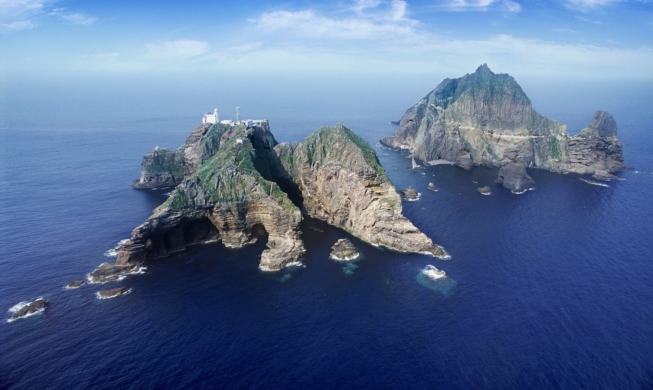View this article in another language
- 한국어
- English
- 日本語
- 中文
- العربية
- Español
- Français
- Deutsch
- Pусский
- Tiếng Việt
- Indonesian
On Feb. 9, the Korean Cultural Center in the Philippines opened its first media art exhibition for 2017 featuring the works of contemporary multimedia artist Han Ho. The exhibit is titled "Eternal Light."
According to the Korean Cultural Center, “‘Eternal Light’ by Han Ho explores the nature of human emotions, inner conflict and hope. Using traditional Hanji mulberry paper, Han Ho combines light in his traditional paintings to create a new form of art. He also employs projected light in his art installations, and uses different materials to choreograph patterns of reflected light.”
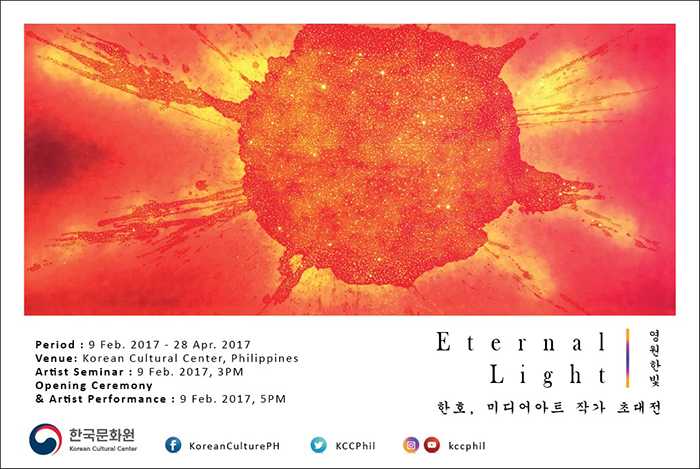
Han Ho has been called the successor to the "father of contemporary video art," media-based artist Nam June Paik.
A fine art graduate from Paris 8 Vincennes University, Han Ho has held exhibitions all over the globe, from Seoul and France to New York, Brazil, Germany and Japan. He has certainly made his mark. Of course, I couldn’t miss the chance to meet Han Ho and to hear his thought process that brought his creations alive. I was really interested in attending the opening ceremony, as I was intrigued by his works, which combine art and technology.
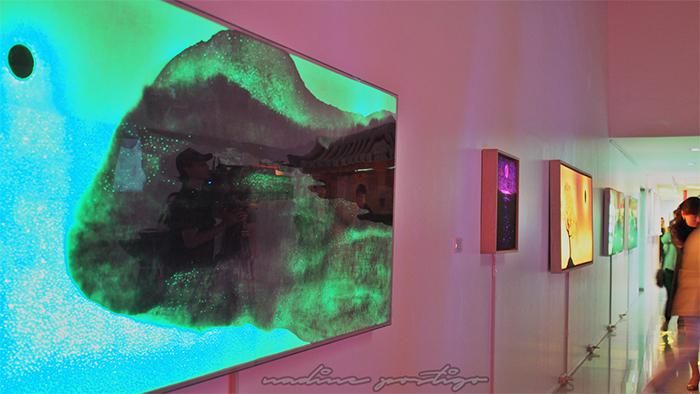
The event started with the artist’s lecture. Videos from Han Ho’s previous exhibits and works were played first, for us to get to know him and his creations.
Listening to the inspirations behind his artworks was fascinating. A lot of his art is inspired by his childhood memories, the Bible, history, landscape and humanity, among other things. Introspection plays a big role in his works of art, as he aims for his audience to be able to reflect.
I was particularly moved when he shared the story of an artwork installation that was a commemoration to the victims who died during the sinking of the Sewol ferry. He visited the school involved, in Ansan, from which most of victims came, and talked to the families and shared their grief. He wanted to convey the reflection and dreams of the children affected by the incident.
The translator further explained that Han Ho wanted to commemorate the unrealized dreams of the students. “He wanted to convey their deep sadness by showing artwork that is reflected from aluminum mirrors and water, which showed the gentle waves of the sea."
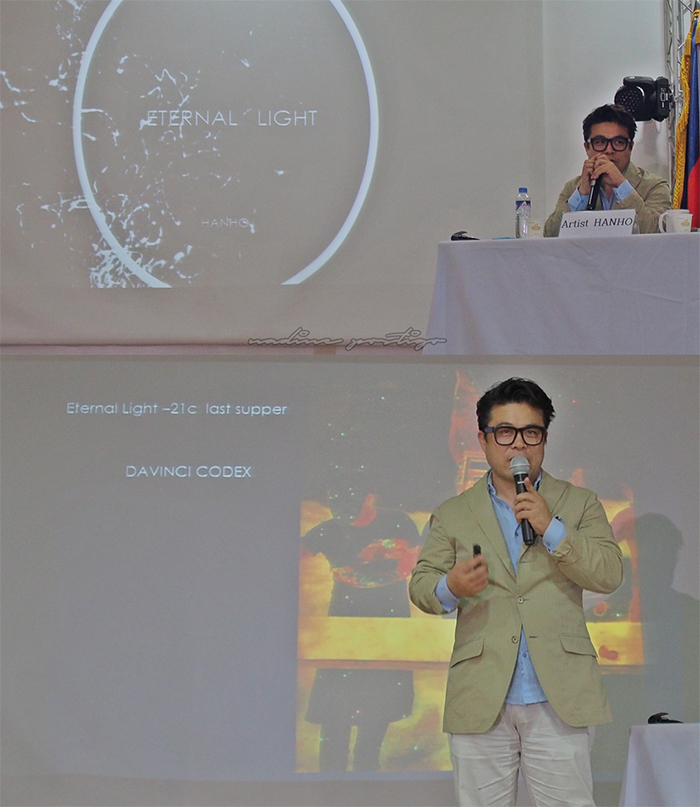
The main components of Han Ho’s art works are made of traditional hand-made mulberry Hanji paper and LED lights. He then explained how he creates his paintings, which I find very meticulous. He said that he has to manually punch holes in the canvasses, one by one. He then mounts the LED lights behind the canvas so the light can express his painting.
As he mentioned, the LED lighting actually looks like diamonds in his paintings. LED lights are cheap, they last a long time and have low power consumption. The way the color changes is also vital for his work.
Using the same technique, Han Ho has transitioned from 2-D paintings to 3-D, giving you more illusions.
When asked what he would advise aspiring artists, Han Ho stated that one should find their identity. “What makes you unique? I want to find my style. Where is my style? What is your originality? Your own material." As for Han Ho, he emphasized that he was proud to use traditional mulberry paper. So the mixture of Hanji and LED lights is one of his unique traits that makes his artwork distinctly his.
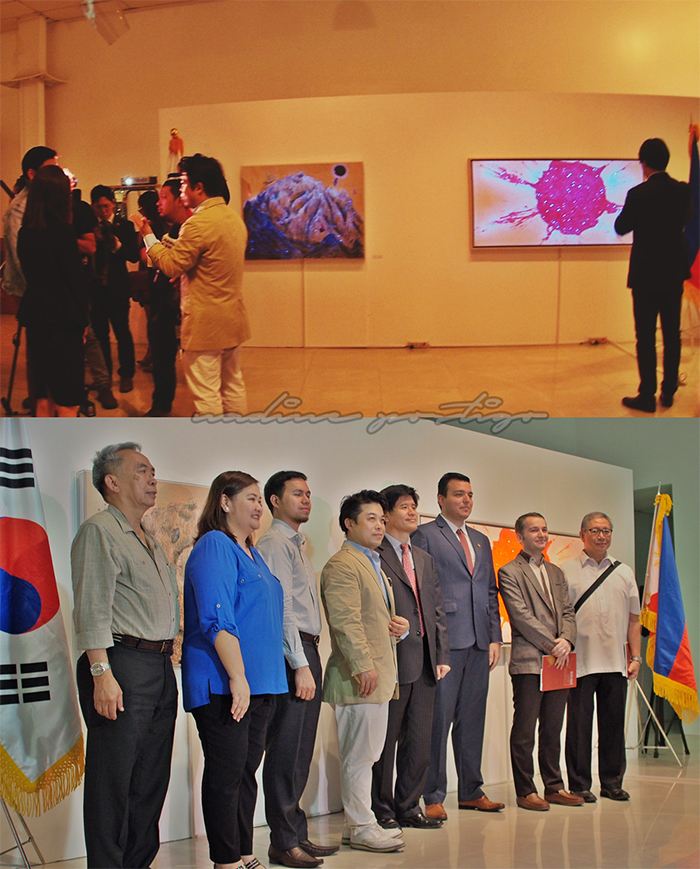
The second half of the event was the official opening of the exhibition. Artist Han Ho gave the audience a treat as he conducted a live performance of his art.
Director Oh Choong-suk of the Korean Cultural Center in the Philippines stated in his opening remarks that this is the first time that the KCC will be holding an art exhibition that uses light as a tool.
"I'm very excited to introduce this new and interesting medium to the Philippine people. Using traditional mulberry paper, Han Ho combines touches and light in his paintings. He also enjoys projecting light as part of his art. I hope that through this exhibit of media and visual art, there will be a lot of interest in the Philippines.”
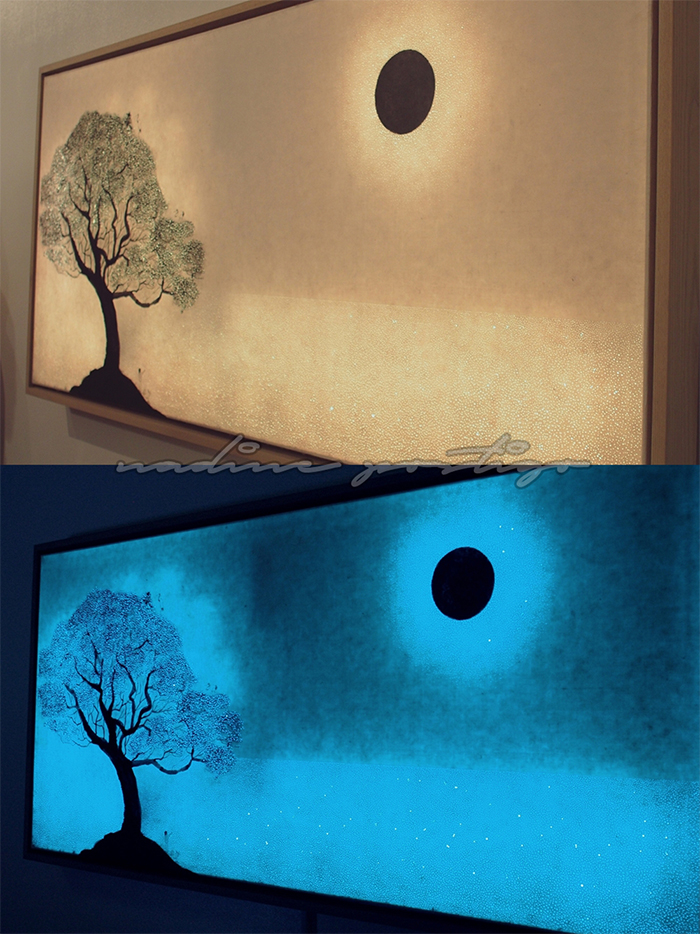
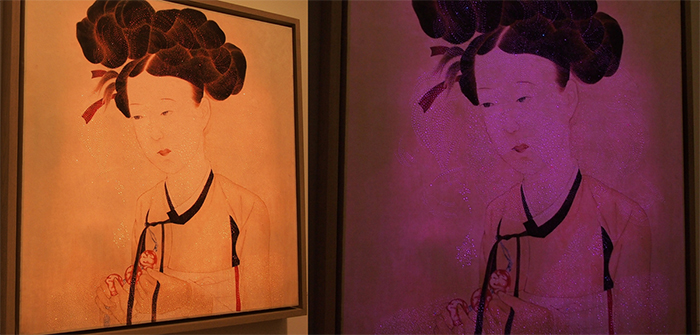
Thirteen paintings and media artworks, and two installation works, were on display. In a brightly lit room, visitors could see the beauty of his paintings at first glance. However, once the lights in the room are dimmed and the various LED lights come out from his artworks, then one feels most at awe. I certainly felt mesmerized, as if I was transported to a different world. The way Han Ho integrated light in his artworks was truly captivating. I’d like to describe it as "the beauty of light in the darkness." It was the first time that I’ve personally seen an artist do new media art and it was a great and inspiring experience.
Han Ho reinterpreted the famous "The Last Supper" by Leonardo Da Vinci, recreating as "The 21st Century Last Supper," which was showcased at the DaVinci Codex in Korea. It’s one of his works of art that I would love to see as well.
"I hope people can experience the impression of my works. Given by the change of light, this is not a one-time experience. It's a continuously changing emotion. You can experience discomfort, fear and chaos that many people feel while facing many problems in contemporary society. At the same time, you can also dream, hope and feel healing from these works. I would like to convey them to the audience sequentially, through light.”
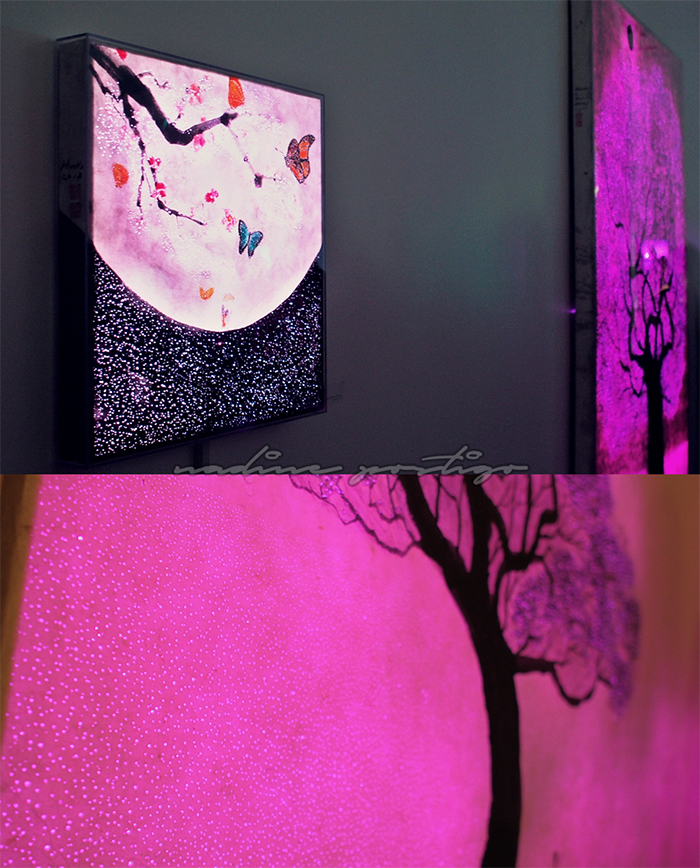
I also noticed that another recurring theme in his artwork involved paradise. For his work entitled "Paradise," he explained that it came from the notion that humans always dream of their own paradise.
The "Eternal Light" exhibition will be open until April 28 at the Korean Cultural Center Exhibition Hall.
You can catch a glimpse of what transpired at the opening ceremony and what you can see at the exhibit in the video below.
By Nadine Postigo
Korea.net Honorary Reporter
Photo: Nadine Postigo, Korean Cultural Center in the Philippines
Video: Nadine Postigo
http://koreanetblog.blogspot.kr/2017/02/han-ho-art-exhibit-comes-to-manila.html
According to the Korean Cultural Center, “‘Eternal Light’ by Han Ho explores the nature of human emotions, inner conflict and hope. Using traditional Hanji mulberry paper, Han Ho combines light in his traditional paintings to create a new form of art. He also employs projected light in his art installations, and uses different materials to choreograph patterns of reflected light.”

Han Ho has been called the successor to the "father of contemporary video art," media-based artist Nam June Paik.
A fine art graduate from Paris 8 Vincennes University, Han Ho has held exhibitions all over the globe, from Seoul and France to New York, Brazil, Germany and Japan. He has certainly made his mark. Of course, I couldn’t miss the chance to meet Han Ho and to hear his thought process that brought his creations alive. I was really interested in attending the opening ceremony, as I was intrigued by his works, which combine art and technology.

The event started with the artist’s lecture. Videos from Han Ho’s previous exhibits and works were played first, for us to get to know him and his creations.
Listening to the inspirations behind his artworks was fascinating. A lot of his art is inspired by his childhood memories, the Bible, history, landscape and humanity, among other things. Introspection plays a big role in his works of art, as he aims for his audience to be able to reflect.
I was particularly moved when he shared the story of an artwork installation that was a commemoration to the victims who died during the sinking of the Sewol ferry. He visited the school involved, in Ansan, from which most of victims came, and talked to the families and shared their grief. He wanted to convey the reflection and dreams of the children affected by the incident.
The translator further explained that Han Ho wanted to commemorate the unrealized dreams of the students. “He wanted to convey their deep sadness by showing artwork that is reflected from aluminum mirrors and water, which showed the gentle waves of the sea."

The main components of Han Ho’s art works are made of traditional hand-made mulberry Hanji paper and LED lights. He then explained how he creates his paintings, which I find very meticulous. He said that he has to manually punch holes in the canvasses, one by one. He then mounts the LED lights behind the canvas so the light can express his painting.
As he mentioned, the LED lighting actually looks like diamonds in his paintings. LED lights are cheap, they last a long time and have low power consumption. The way the color changes is also vital for his work.
Using the same technique, Han Ho has transitioned from 2-D paintings to 3-D, giving you more illusions.
When asked what he would advise aspiring artists, Han Ho stated that one should find their identity. “What makes you unique? I want to find my style. Where is my style? What is your originality? Your own material." As for Han Ho, he emphasized that he was proud to use traditional mulberry paper. So the mixture of Hanji and LED lights is one of his unique traits that makes his artwork distinctly his.

The second half of the event was the official opening of the exhibition. Artist Han Ho gave the audience a treat as he conducted a live performance of his art.
Director Oh Choong-suk of the Korean Cultural Center in the Philippines stated in his opening remarks that this is the first time that the KCC will be holding an art exhibition that uses light as a tool.
"I'm very excited to introduce this new and interesting medium to the Philippine people. Using traditional mulberry paper, Han Ho combines touches and light in his paintings. He also enjoys projecting light as part of his art. I hope that through this exhibit of media and visual art, there will be a lot of interest in the Philippines.”


Thirteen paintings and media artworks, and two installation works, were on display. In a brightly lit room, visitors could see the beauty of his paintings at first glance. However, once the lights in the room are dimmed and the various LED lights come out from his artworks, then one feels most at awe. I certainly felt mesmerized, as if I was transported to a different world. The way Han Ho integrated light in his artworks was truly captivating. I’d like to describe it as "the beauty of light in the darkness." It was the first time that I’ve personally seen an artist do new media art and it was a great and inspiring experience.
Han Ho reinterpreted the famous "The Last Supper" by Leonardo Da Vinci, recreating as "The 21st Century Last Supper," which was showcased at the DaVinci Codex in Korea. It’s one of his works of art that I would love to see as well.
"I hope people can experience the impression of my works. Given by the change of light, this is not a one-time experience. It's a continuously changing emotion. You can experience discomfort, fear and chaos that many people feel while facing many problems in contemporary society. At the same time, you can also dream, hope and feel healing from these works. I would like to convey them to the audience sequentially, through light.”

I also noticed that another recurring theme in his artwork involved paradise. For his work entitled "Paradise," he explained that it came from the notion that humans always dream of their own paradise.
The "Eternal Light" exhibition will be open until April 28 at the Korean Cultural Center Exhibition Hall.
You can catch a glimpse of what transpired at the opening ceremony and what you can see at the exhibit in the video below.
By Nadine Postigo
Korea.net Honorary Reporter
Photo: Nadine Postigo, Korean Cultural Center in the Philippines
Video: Nadine Postigo
http://koreanetblog.blogspot.kr/2017/02/han-ho-art-exhibit-comes-to-manila.html
Most popular
- Grammy-winning producer calls Suga of BTS 'amazing artist'
- 'Universal love, family' themes fuel success of 'King of Kings': director
- Council sets minimum hourly wage in 2026 at KRW 10,320
- Expansion of foreign app system raises tourist convenience
- Nat'l population diversity rose nearly 8% from 2018-22: study
